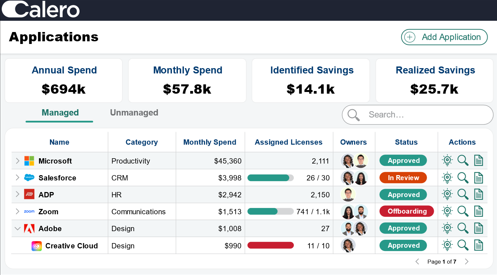To reduce SaaS spend, improve ROI, and strengthen vendor relationships, finance leaders must take a structured, data-driven approach to managing and negotiating SaaS agreements. This means preparing early, rightsizing based on usage, and walking into a renewal conversation with leverage.
SaaS Contract Management: Optimizing Your SaaS Agreements
SaaS contracts have become a major line item in every financial leader’s budget. Yet, despite the growing spend, many organizations still approach SaaS contract management with outdated practices. Practices including treating renewals as automatic and sizing agreements based on estimates rather than actual usage. Organizations should shift from reactive contract maintenance to proactive optimization.
To reduce SaaS spend, improve ROI, and strengthen vendor relationships, finance leaders must take a structured, data-driven approach to managing and negotiating SaaS agreements. This means preparing early, rightsizing based on usage, and walking into a renewal conversation with leverage.
Why SaaS Contracts Deserve More Scrutiny
SaaS agreements are easy to purchase, but not always easy to manage. They often renew automatically and scale quietly. They are frequently purchased items department by department, which leaves finance teams without a centralized view of total spend.
Without proper oversight, organizations risk:
- Paying for unused or underutilized licenses
- Locking into long-term deals that don’t fit evolving needs
- Losing negotiating power because of missed renewal windows
- Duplicating functionality across teams and tools
In short, unmanaged SaaS contracts become a silent source of waste. With the right processes in place, they can become an opportunity for optimization and savings.
Navigating with Visibility and Usage Data
Companies can’t optimize SaaS licenses that are not visible. That’s why effective SaaS contract management begins with full visibility into your software portfolio. This includes what licenses you’re paying for, who’s using it, and how it aligns with your business goals.
To build a foundation for smart contract decisions:
- Identify every active SaaS subscription across departments
- Track actual license utilization over time
- Categorize apps by function, user base, and criticality
- Flag redundant or overlapping tools
- Review historical contract terms, usage patterns, and price trends
With this data, you can strategically understand how your organization uses SaaS applications. Then you can start negotiating SaaS contracts based on actual usage, not vendor predictions.

Right-Size Before You Renew
Renewals are the single best opportunity to fix bad deals, but only if you prepare in advance. Too often, companies rush into renewals with limited context, letting vendors lead the process.
To optimize your SaaS agreements, embark upon the right-sizing process before they renew.
Key steps include:
- Reviewing current license counts versus actual active users
- Scaling down unused seats and negotiating volume-based discounts
- Consolidating multiple agreements from the same vendor into one contract
- Ensuring contract terms allow for future scalability without penalties
- Leveraging SaaS renewal management tools to ensure your company is aware of all upcoming renewals and contracts
This kind of rightsizing ensures you’re paying only for what you need, while still leaving room to grow.
Conquering the Renewal Process
Unlike traditional perpetual licenses, SaaS agreements come with recurring costs and recurring chances to renegotiate. The SaaS renewal process should be your moment of power.
Here’s a SaaS contract negotiation checklist to prepare effectively:
- Start 90–120 days before renewal: The earlier you begin, the more leverage you have.
- Benchmark pricing: Compare rates with similar-sized companies or third-party benchmarks.
- Push for flexibility: Include downgrade clauses, exit options, and user scalability in the agreement.
- Challenge uplifts: Don’t accept automatic price increases without justification.
- Loop in stakeholders: Ensure IT and department heads validate actual need.
Be prepared and you won’t just renew; you’ll renegotiate on your terms.
Best Practices to Sustain Optimization
Optimizing SaaS contracts is an ongoing discipline that should be built into your procurement and budgeting cycles.
To keep your SaaS portfolio in check:
- Establish a central repository for all contracts and renewal dates
- Implement regular license usage reviews
- Involve finance in early stages of SaaS procurement
- Create cross-functional governance to assess tool overlap and value
- Use a SaaS management platform to automate monitoring and alerts
By embedding these SaaS contract best practices into your financial operations, you move from passive oversight to active control. You start driving smarter spend and better outcomes.
Reimagining with your SaaS Contracts
SaaS growth should not lead to uncontrolled spend. With structured SaaS contract management, finance leaders can cut waste, improve forecasting, and turn renewals into strategic opportunities.
For organizations, methodic SaaS control is how you conquer growing SaaS usage.
Ready to take control of your SaaS Estate?
Book a demo today and see how you can optimize your global technology management.
Calero | Technology Business Management Solutions Optimize costs, inventory, and operations for SaaS, mobility, telecom, and beyond with a single unified technology business management platform.


